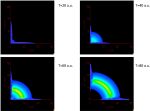EPJ D Colloquium – An accurate method to measure scattering non-perturbatively
- Details
- Published on 26 November 2012

Atomic and molecular collisions occurring at low impact energies and for neutral targets need adequate methods for accurately measuring their scattering properties. Such measures are fundamental to the description of the dynamics of plasmas and provide insight into the long-range Coulomb interactions between charged particles. In the last twenty years many novel non-perturbative approaches have been applied. The time-dependent close-coupling (TDCC) approach, discussed in this EPJD Review, differs fundamentally from previous non-perturbative approaches in that it solves the time-dependent, rather than time-independent, Schr¨odinger equation. This Review provides a detailed description of the application of the time-dependent close-coupling approach to ionising collisions of electrons, photons and ions with small atoms and molecules.
The TDCC approach takes advantage of the rapid advances made in high-performance computing resources to efficiently solve the discretized Schr¨odinger equation for two (or more) electrons moving in the field of a charged nucleus (or nuclei). The authors present the pertinent coupled equations that need to be solved for the problem under consideration, and show how scattering information may be extracted by suitable projection methods. They then discuss some of the resulting cross sections and angular distributions for a variety of scattering processes, and briefly show how these calculations can shed some insight on the underlying physical picture governing the scattering events.
Application of the time-dependent close-coupling approach to few-body atomic and molecular ionizing collisions. J. Colgan and M.S. Pindzola (2012) Eur. Phys. J. D 66: 284, DOI: 10.1140/epjd/e2012-30517-2




